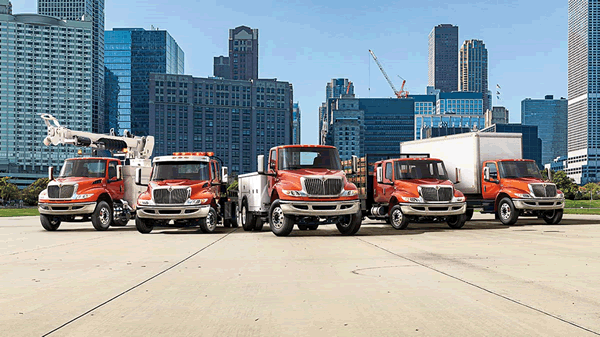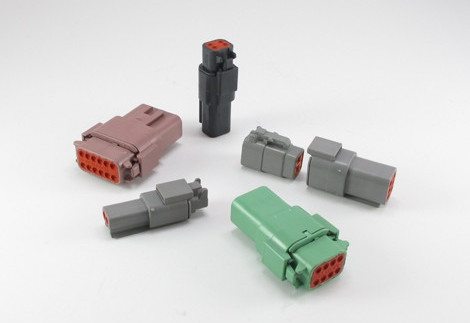New Truck Rollouts Make Room for More Connectors
Recent introductions in the work truck market highlight the ongoing rise in electronic features and functions.
By Terry Costlow
The role of electronic technologies continues to grow in the commercial trucking world. Companies are finding more niches for electrified systems and powertrains in trucks destined for all markets. Several introductions at the recent Work Truck Show in Indianapolis highlighted the growing demands for electronics and the connectors that tie them together. Ram Trucks, International, and General Motors unveiled a variety of new vehicles at the show. The concurrent Green Truck Summit detailed the growing role of electric powertrains was detailed at. Both events were sponsored by the NTEA, the Association for the Work Truck Industry.
General Motors made a big splash by re-entering the medium-duty market with three Silverado models in the Class 4–6 range. Connectivity was among the electronic highlights in the highly publicized announcement from GM, which abandoned this segment in 2009, the year of its bankruptcy.

Connectivity is a highlight for GM’s Silverado.
The Diamond Logic electrical system got the spotlight when International unveiled its MV line, which is also in Class 4–6, the medium-level work truck. It offers work truck customers, who typically customize vehicles for their jobs, nearly 200 factory available body integration and driver efficiency features, plus the ability to customize infinitely more vehicle functions.
“Our Diamond Logic electrical system is known for its ability to provide control and communication between trucks and body equipment,” said Jeff Sass, senior vice president, sales and marketing.

International’s MV line is designed for customization.
The MV’s flat-panel dash contains space for up to 30 customizable switches, ensuring functionality for any type of body that is mounted on the back. The line also features a best-in-class HVAC system.
Ram Trucks focused on electronics in its 1500 Tradesman, adding more than 100 safety features, including lane departure, front collision warning systems, and 360-degree surround-view cameras.
Large commercial trucks unveiled in Indianapolis also mirrored this trend. The Hino XL Series features new active safety solutions with electronic stability control and collision mitigation systems, hands-free Bluetooth audio/calling, steering wheel controls, LED headlights, cruise control, and air conditioning. These features will all be standard equipment in 2020.
The trend to differentiate work trucks using electronics creates solid growth opportunities for connector and wiring suppliers. It follows developments in passenger cars, which drive many of the technologies used in trucks. The importance of connectors and wiring was recently discussed in a Siemens meeting at the Digital Manufacturing and Design Innovation Institute (DMDII) in Chicago. Wally Rhines, CEO of Siemens’ Mentor business group, detailed this growing role in a discussion of autonomous vehicles.
“With SAE Level 4 autonomy, there will be even more sensors, so wiring will be more complex. Already today, there’s around 1.5 miles of wiring in a car. The wiring harness is the third or fourth most expensive subsystem in a car, and it’s one of the most complex parts to build,” Rhines said. Level 4 is the second highest level in the SAE’s autonomous driving hierarchy.
Elsewhere in the conference, the trend away from fossil fuels was highlighted by a range of upfitters who showed technologies for customizing commercial trucks with battery power for driving and other functions now handled by hydraulics.
Isuzu showed an electric version of its N-Series truck that was converted by Nordresa, a Canadian producer of electrified powertrains. Ford showed three vehicles produced by participants in its Qualified Vehicle Modifier (QVM) program, which was announced at last year’s show. Ford promoted vehicles upfitted by XL, Motiv Power Systems, and Lightning Systems.
Shifting from diesel fuel to alternative power sources is the goal of newcomers who weren’t ready to show vehicles this year. Tesla has announced plans to develop an electric-powered heavy-duty truck.
Another newcomer, Nikola Corp., has teamed up with TE Connectivity to create a semi that uses hydrogen fuel cells instead of diesel fuel. The partnership further underscores the role of connectors in emerging vehicles.
Among the connectors used by Nikola are TE’s high voltage connectors, which have integrated high voltage interlocks (HVIL) to ensure that the system is safe from high-voltage potentials when the connectors are in an unmated condition. The HVIL also ensures that the unmating of the terminals is completed with the high-voltage potential removed.

TE’s DEUTSCH line is used in startup Nikola’s fuel cell vehicle.
This eliminates any possibility of destructive arcing to occur between the terminals during the unmating process. The high-voltage connectors are fully shielded to keep electromagnetic pulses from interfering with other critical circuitry. Nikola also uses TE’s standard DEUTSCH connectors for more conventional electronic functions.
As advancements in technology become the most compelling features of new vehicle releases, connectors come into the forefront. Today’s trucks couldn’t run without them.
- State of the Industry: 2022-2023 Connector Sales - April 16, 2024
- Amphenol is On a Roll - April 2, 2024
- Nicomatic Proves That Two Heads are Better Than One - March 26, 2024





